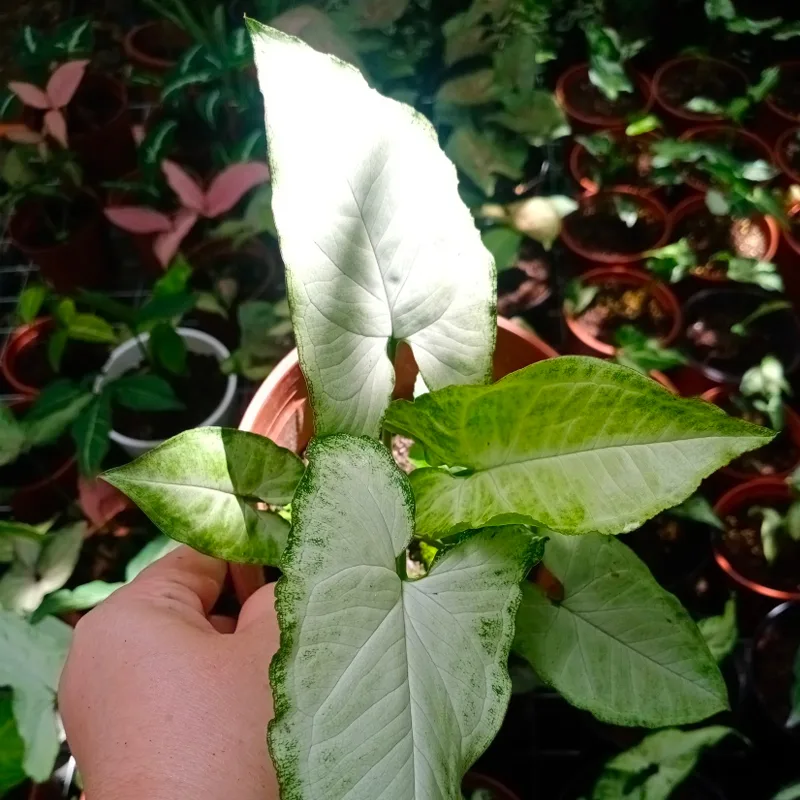
Syngonium Exotic Allusion: Your Guide to This Alluring Houseplant
Hi, Ferb Vu here! Today, we’re diving into the world of the captivating Syngonium Exotic Allusion. This houseplant boasts stunning foliage and a relatively easy-going personality, making it a perfect choice for both seasoned plant parents and curious beginners.
What is a Syngonium Exotic Allusion?
The Syngonium Exotic Allusion is a captivating member of the Syngonium podophyllum family, commonly known as the Arrowhead Plant. This specific cultivar, however, stands out with its mesmerizing variegation. Imagine a base of light green adorned with creamy white speckles and mottling. The effect is truly captivating, living up to its “Exotic Allusion” namesake.
Light Requirements: Finding the Perfect Spot
Syngonium Exotic Allusion thrives in bright, indirect light. Think dappled sunlight filtering through a sheer curtain. Harsh, direct sunlight can scorch the delicate leaves, so avoid placing it in a south-facing window. East or north-facing windows are ideal. If you only have brighter light available, sheer curtains or positioning the plant a few feet back from the window can help diffuse the intensity.
Tip: Rotate your Syngonium Exotic Allusion regularly to ensure even growth.
Watering Needs: Keeping the Balance
Like most houseplants, the Syngonium Exotic Allusion prefers consistent moisture but dislikes soggy soil. The key is finding that sweet spot. Here’s how:
- Feel the soil: The top inch or two of the potting mix should dry out before watering again. Stick your finger in the soil to check.
- Drench and Drain: When watering, thoroughly soak the soil until water runs out the drainage holes. This ensures all the roots receive moisture. Discard any excess water collected in the saucer to prevent root rot.
Remember: Underwatering is generally better than overwatering for this plant.
Humidity: Mimicking the Tropics
Syngonium Exotic Allusion hails from tropical regions, so it appreciates moderate to high humidity levels (around 50-60%). Here are some ways to create a more humid environment:
- Grouping plants: Clustering your Syngonium Exotic Allusion with other humidity-loving plants creates a mini microclimate.
- Pebble tray: Fill a shallow tray with pebbles and water. Sit your plant pot on top (elevated on the pebbles) so it doesn’t sit in the water. As the water evaporates, it will increase humidity around the plant.
- Humidifier: For a more long-term solution, consider a humidifier to consistently add moisture to the air.
Note: While misting can be helpful occasionally, it’s not a substitute for proper humidity levels.
Fertilizing for Optimal Growth
During the growing season (spring and summer), you can give your Syngonium Exotic Allusion a light feeding every 2-4 weeks with a balanced houseplant fertilizer diluted to half strength. In the fall and winter, when growth slows, fertilizing can be reduced or stopped altogether.
Keep in mind: Overfertilizing can damage the plant, so it’s always better to err on the side of less.
Common Concerns: Troubleshooting Your Syngonium Exotic Allusion
Drooping Leaves: This is often a sign of underwatering. Give your plant a thorough watering and see if it perks up within a day or two.
Brown Spots on Leaves: This can be caused by several factors, including underwatering, sunburn, or fungal disease. Check the watering schedule and light conditions. If fungal disease is suspected, isolate the plant and treat it with a fungicide according to the product’s instructions.
Yellowing Leaves: This is a natural part of the aging process. Remove yellowing leaves to encourage new growth. However, excessive yellowing could indicate overwatering, nutrient deficiency, or insufficient light.
Syngonium Exotic Allusion vs. Other Syngonium Varieties
The Syngonium family boasts a diverse range of colors and patterns. Here’s a quick comparison of the Syngonium Exotic Allusion with two popular varieties:
- Syngonium Podophyllum ‘Neon Lime’: This variety features vibrant lime green foliage, a stark contrast to the lighter green and white variegation of the Exotic Allusion.
- Syngonium Pink Allusion: This relative shares the “Allusion” name but boasts stunning pink variegation on green leaves.
Ultimately, the best choice depends on your personal preference and the aesthetic you’re aiming for in your plant collection.
Propagation: Sharing the Allure
Syngonium Exotic Allusion can be easily propagated through stem cuttings. Here’s a simplified guide:
- Choose a healthy stem with at least two nodes (the bumps where leaves emerge).
- Using sharp, sterilized pruning shears, cut the stem just below a node. Make sure to include at least one leaf on the cutting.
- You can either propagate in water or soil. For water propagation, place the stem cutting in a glass or jar filled with fresh, room-temperature water, ensuring the node is submerged. For soil propagation, plant the cutting in a pot filled with a well-draining potting mix, keeping the soil slightly moist.
- Whichever method you choose, place the propagating container in a warm location with bright, indirect light. Be patient – rooting can take several weeks. Once new growth appears on the cutting, you can transplant it to a larger pot with fresh potting mix.




